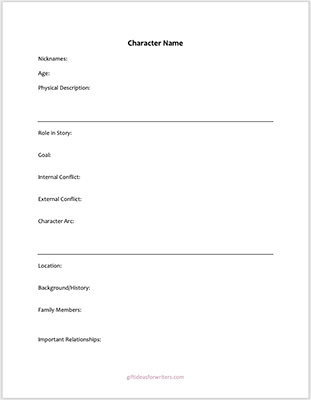
Great stories and novels hinge on great characters. While the perfect hero or villain may appear in your mind fully formed and three dimensional, you may need to brainstorm your character before you start your new story. One of the techniques to create engaging, realistic, and well-rounded characters is to create a character profile. If you’re new to writing or trying to figure out a better way to develop characters, read on. This character profile works for creating protagonists, antagonists, and even side characters.
How to Create a Character Profile
What is a Character Profile?
In its most basic form, a character profile is a tool used by writers to help develop a well-rounded and realistic character. They’re generally used for main characters (the hero and villain) as well as other major side characters. The type and level of detail of character profiles differ for each writer who uses them. While many authors use a standard profile of facts that they fill out for each character, many have developed their own quirky and interesting processes that fit their writing style. Feel free to try any of these ideas to figure out what works best for you and your story or book.
Character profiles aren’t only great brainstorming tools for developing new characters but they’re extremely helpful reference points. Continuity issues can pop-up in any story, but they’re especially common in novels and series. To avoid writing your character with blue eyes in Chapter 1 and brown eyes in Chapter 12, you can easily reference your character profile as you work. Even if you’re a pantser who likes to start a story with minimal planning, figuring out some of the basic facts for your main characters will make rewriting and editing a lot easier.
Standard Character Profile
This is the most common type of character profile that many writers use. Frequently you’ll see templates online that work great. They list different facets of your character to brainstorm, from basic biographical facts to conflicts and character arcs.
If you don’t want to use a template, you can easily create your own character profile using a piece of paper or a blank text document. Make sure to include details about your character’s name, age, physical description, and background. You’ll also want to explore their relationships to other characters and to the plot of the story. Details like character flaws, weaknesses, and fears will help you develop your story and set up obstacles for your character.
I recommend considering the following when you create your character profile:
- How old are they?
- What do they look like?
- Where are they from?
- Who are the important people in their life?
- What is their goal?
- What is their motivation?
- What do they fear?
- What is their history?
- What is their personality?
- What are their internal/exernal conflicts?
The elements you figure out for your character can be broad or extremely detailed. Some writers enjoy getting into the nitty-gritty details, especially with their main characters. They’ll figure out the character’s favorite color or ice cream character before they start writing their story. With practice, you’ll figure out the best balance for your writing workflow.
You may not be able to answer each prompt before you start the story. Often the character will reveal more about themselves as they
Check out our free template below to help you get started.
Character Biography or Letter to the Author
The character biography is a different take on creating a character profile. Rather than filling out a bunch of stats about a character, this is a free-flowing way to flesh out a new character. Many authors prefer this less formal exercise.
There are a few forms this can take. The simplest is a biography of the character. Starting with their birth (or even starting with their parents before their birth), write out the information about their life history. Think back to when you wrote biographical papers in school about historical figures. You’ll want to include major life events that shape who your character is as well as details of their personality, preferences, and relationships. This is also a good time to think about what happened to your character before the start of the story that may affect the plot or arc.
Another approach to the biography is the letter. This is a letter written from the character to the author, introducing themselves and whatever situation they may find themselves in at the beginning of the story. This exercise is a great way to work out the character’s voice and is perfect if you plan to write your story in the character’s first person POV.
Download a Free Character Profile Template

This character profile worksheet makes a great starting point for any writer in any genre. Feel free to remove or add to the profile for your own writerly needs. Happy writing!
Download PDF
Download for Word
(Right click “Save Link As” to download to your computer.)
Save on Pinterest

Searching for character inspiration? Check out our Pinterest Board of Character Pictures to jump start your imagination.
Successfully complete your novel by setting achieveable writing goals. Use these books on writing fiction to develop your craft.
